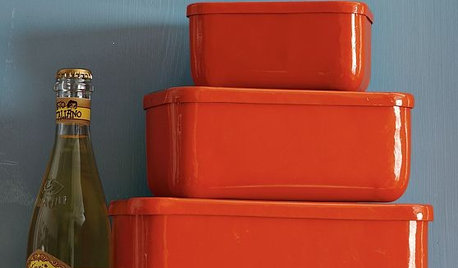Getting started on food storage
sally2_gw
11 years ago
Related Stories

DECORATING GUIDESHow to Decorate When You're Starting Out or Starting Over
No need to feel overwhelmed. Our step-by-step decorating guide can help you put together a home look you'll love
Full Story
FARM YOUR YARD6 Things to Know Before You Start Growing Your Own Food
It takes time and practice, but growing edibles in the suburbs or city is possible with smart prep and patience
Full Story
GARDENING GUIDESSeeds or Seedlings? How to Get Your Garden Started
Growing delicious herbs and vegetables starts with knowing your goals and when you want to plant
Full Story
GARDENING GUIDESGet a Head Start on Planning Your Garden Even if It’s Snowing
Reviewing what you grew last year now will pay off when it’s time to head outside
Full Story
HOUSEPLANTSHow to Grow Orchids Indoors
Orchids are the exotic aristocrats of the flower world and can make themselves comfortable in almost any home
Full Story
TRADITIONAL HOMESHouzz Tour: Family Gets a Fresh Start in a Happy New Home
Decorating her house from scratch spurs a big career change for this designer
Full Story
DECORATING GUIDESFresh Start: 39 Ways to Organize Your Stuff
Jumpstart your year with great storage ideas from the Houzz community
Full Story
MOST POPULAROrganized From the Start: 8 Smart Systems for Your New House
Establishing order at the outset will help prevent clutter from getting its foot in the door
Full Story
DECORATING GUIDESDecorating 101: How to Start a Decorating Project
Before you grab that first paint chip, figure out your needs, your decorating style and what to get rid of
Full Story
KITCHEN DESIGNGuest Picks: A Clean Start In the Kitchen
20 stylish ways to get your cooking area organized
Full Story





grainlady_ks
sally2_gwOriginal Author
Related Discussions
Food Storage Tips?
Q
Is the fridge part of food prep or storage?
Q
Your Best Stay Fresh Longer Food Storage Tips !!!
Q
FoodSaver and Dehydrated Food Storage
Q
shambo
User
grainlady_ks
sally2_gwOriginal Author
triciae
triciae
grainlady_ks
shambo
triciae
shambo
centralcacyclist
shambo
grainlady_ks
centralcacyclist
triciae
triciae
sally2_gwOriginal Author
grainlady_ks
jpeterson3153
cloudy_christine
lbpod
triciae
grainlady_ks
cloudy_christine
malna
jpeterson3153
sally2_gwOriginal Author
readinglady
John Liu
grainlady_ks
dcarch7 d c f l a s h 7 @ y a h o o . c o m
triciae
foodonastump
triciae
sally2_gwOriginal Author
annie1992
triciae
annie1992
shambo
cynic
grainlady_ks
shambo
grainlady_ks
shambo
sally2_gwOriginal Author
grainlady_ks
beth_b_kodiak
sooz